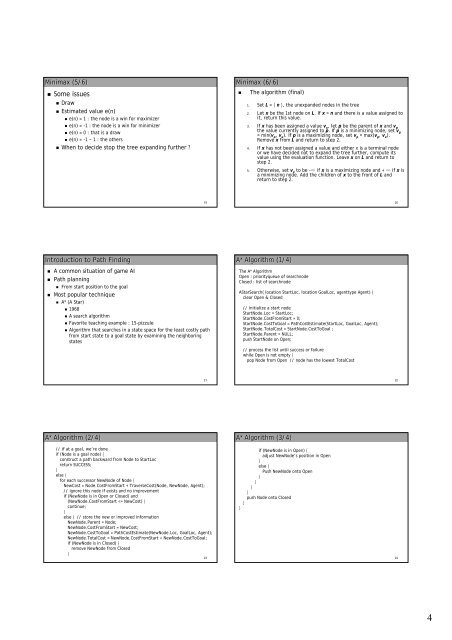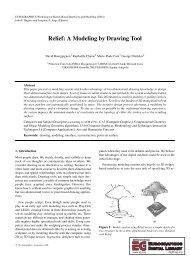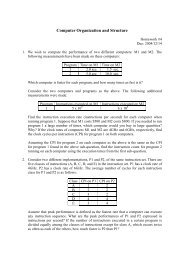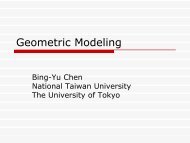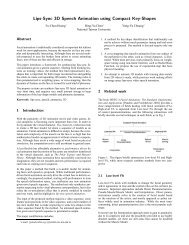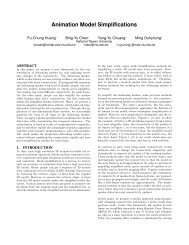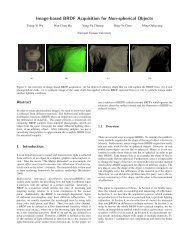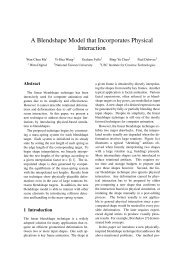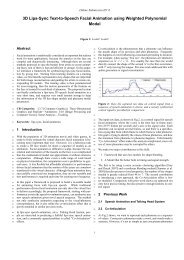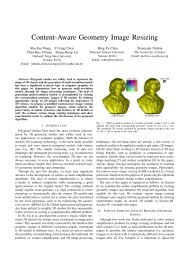pdf(for print) - Computer Graphics Laboratory
pdf(for print) - Computer Graphics Laboratory
pdf(for print) - Computer Graphics Laboratory
You also want an ePaper? Increase the reach of your titles
YUMPU automatically turns print PDFs into web optimized ePapers that Google loves.
Minimax (5/6)<br />
• Some issues<br />
• Draw<br />
• Estimated value e(n)<br />
• e(n) ) = 1 : the node is a win <strong>for</strong> maximizer<br />
• e(n) ) = -11 : the node is a win <strong>for</strong> minimizer<br />
• e(n) ) = 0 : that is a draw<br />
• e(n) ) = -11 ~ 1 : the others<br />
• When to decide stop the tree expanding further <br />
Minimax (6/6)<br />
• The algorithm (final)<br />
1. Set L = { n }, the unexpanded nodes in the tree<br />
2. Let x be the 1st node on L. . If x = n and there is a value assigned to<br />
it, return this value.<br />
3. If x has been assigned a value v x , let p be the parent of x and v p<br />
the value currently assigned to p. . If p is a minimizing node, set v p<br />
= min(v p , v x ). If p is a maximizing node, set v p = max(v p , v x ).<br />
Remove x from L and return to step 2.<br />
4. If x has not been assigned a value and either x is a terminal node<br />
or we have decided not to expand the tree further, compute its<br />
value using the evaluation function. Leave x on L and return to<br />
step 2.<br />
5. Otherwise, set v x to be –∞ if x is a maximizing node and + ∞ if x is<br />
a minimizing node. Add the children of x to the front of L and<br />
return to step 2.<br />
19<br />
20<br />
Introduction to Path Finding<br />
• A common situation of game AI<br />
• Path planning<br />
• From start position to the goal<br />
• Most popular technique<br />
• A* (A Star)<br />
• 1968<br />
• A search algorithm<br />
• Favorite teaching example : 15-pizzule<br />
• Algorithm that searches in a state space <strong>for</strong> the least costly path<br />
from start state to a goal state by examining the neighboring<br />
states<br />
A* Algorithm (1/4)<br />
The A* Algorithm<br />
Open : priorityqueue of searchnode<br />
Closed : list of searchnode<br />
AStarSearch( location StartLoc, location GoalLoc, agenttype Agent) {<br />
clear Open & Closed<br />
// initialize a start node<br />
StartNode.Loc = StartLoc;<br />
StartNode.CostFromStart = 0;<br />
StartNode.CostToGoal = PathCostEstimate(StartLoc, GoalLoc, Agent);<br />
StartNode.TotalCost = StartNode.CostToGoal ;<br />
StartNode.Parent = NULL;<br />
push StartNode on Open;<br />
// process the list until success or failure<br />
while Open is not empty {<br />
pop Node from Open // node has the lowest TotalCost<br />
21<br />
22<br />
A* Algorithm (2/4)<br />
// if at a goal, we’re done<br />
if (Node is a goal node) {<br />
construct a path backward from Node to StartLoc<br />
return SUCCESS;<br />
}<br />
else {<br />
<strong>for</strong> each successor NewNode of Node {<br />
NewCost = Node.CostFromStart + TraverseCost(Node, NewNode, Agent);<br />
// ignore this node if exists and no improvement<br />
if (NewNode is in Open or Closed) and<br />
(NewNode.CostFromStart


